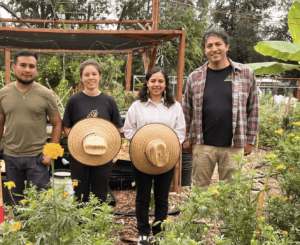COMPOST

Composting plant materials and manure offers a practical way to recycle crop residue and animal waste. The process of decomposition of these materials is sped up to provide a nutrient rich soil conditioner that provides a host of agroecosystem benefits including improvements in:

- Aggregation
- Soil tilth
- Porosity, water infiltration, and water storage
- Fertility and cation exchange capacity
- Soil borne disease suppression
- Soil organic matter and carbon
WHAT DOES THE RESEARCH SAY?
In recent years there has been an increase in the awareness of the multiple benefits compost and organic amendments can offer, in both conventional and organic systems. Compared to synthetic amendments which provide specific nutrients in a relatively quick burst, compost can provide all fourteen of the plant essential nutrients in a slow release form while increasing soil organic matter (SOM) and feeding beneficial soil microbes (6)(10). Increasing soil life has a myriad of benefits such as reduced soil borne diseases (9), weed emergence, and herbicide use (4).
Amendments made with organic materials like compost can significantly increase soil organic matter and sequester soil carbon in California agroecosystems (3)(7). The use of compost can significantly reduce potent nitrous oxide emissions relative to urea-based fertilizer (1). In Mediterranean cropping systems, compost application combined with cover crops or used alone has led to increased soil organic carbon more than any other practice studied including slurry application, cover cropping alone, no-till, and conventional tillage (2). Other benefits related to applying compost to improve soil structure in California cropping systems have also been observed, including: better aggregation and increased porosity, improved water holding capacity, alleviation of compaction (bulk density), and reduced nitrate leaching, surface crusting, and erosion, as well as reduced weed and disease pressure (6)(5)(2)(8).
While the quality of any compost and its nutrient content can vary widely according to feedstock and composting method, with care compost can provide a variety of system-wide benefits to the farm. It’s recommended to test any compost to determine application rates, ensure proper availability of nutrients to plants, and avoid overapplication, runoff, and nutrient loss. Particular care should be taken to prevent overapplication of phosphorus and nitrogen which can lead to eutrophication in waterways.
CAFF’s WORK IN COMPOST
 By advocating in the capital, meeting with regulatory bodies, testifying at hearings, and collaborating with other agricultural groups, CAFF advocates for on-farm composting regulations that are both feasible for farmers and encourage responsible practices.
By advocating in the capital, meeting with regulatory bodies, testifying at hearings, and collaborating with other agricultural groups, CAFF advocates for on-farm composting regulations that are both feasible for farmers and encourage responsible practices.
Learn more about our policy work
COMPOST RESOURCES

CRECE Urban Farm Collective, Spreadwing Farm, and CAFF’s Dave Runsten podcast episode
In this episode we delve into all things on-farm composting, from its production to its use and relevant agricultural policies. We hear from Abel Ruiz at CRECE Farming Collective in

Spreadwing Farm: Compost on a Diversified Small Farm
Spreadwing Farm, located in the Capay Valley, utilizes compost in their vegetable crops to improve the quality of the soil and provide plant available nutrients. Learn more about the benefits,

On Farm Composting Video
This video explores on-farm composting, including a brief overview of California’s new best management practices mandate for on-farm composting as well as the food safety and organic requirements. Hear from

State Water Resources Control Board Limits Regulation of On-Farm Composting
(Updated 4/15/20) The State Water Resources Control Board’s Compost General Order that passed in 2015 presented a regulatory obstacle for on-farm composting, despite the state’s efforts to reduce waste and

California Okays On-Farm Compost, Key to Sustainable Agriculture
Sacramento, CA – After more than five years of negotiations, the State Water Resources Control Board issued a historic decision to allow for much-needed composting on California farms. “Farmers can

Technical Assistance for the Healthy Soils Program
TECHNICAL ASSISTANCE FOR THE HEALTHY SOILS PROGRAM Are you interested in implementing cover crops, compost, hedgerows and other Healthy Soils practices on you farm? The California Department of Food and

Compost: What Does the Research Say?
Composting plant materials and manure offers a practical way to recycle crop residue and animal waste. The process of decomposition of these materials is sped up to provide a

How to Add Compost on Your Small Farm
Compost provides nutrients to plants, improves soil structure, increases water holding capacity, and suppresses root diseases by supporting benefi cial microorganisms in the soil. It also helps improve porosity and

Building Soils for Better Crops
Building Soils for Better Crops is a one-of-a-kind, practical guide to ecological soil management, now expanded and in full color. It provides step-by-step information on soil-improving practices as well as in-depth

Compost Use in Agriculture: Organic Materials Management
Use of composted manures and plant materials in farming has a history almost as long as farming itself. California farmers enjoy access to high-quality compost and mulch products from a variety of

Compost Science Webinar
Originally aired March 8, 2017 | Composting is both an art and a science. For some, composting is a passion and an emotional experience, but often when we start thinking

Agricultural Composting & Water Quality
Composting, a controlled process for stabilization of organic matter, can turn waste into a valuable soil amendment. Creating compost from waste materials provides an opportunity to return nutrients and organic
‘What Does the Research Say?’ References:
- Alluvione, F., Bertora, C., Zavattaro, L., & Grignani, C. (2010). Nitrous oxide and carbon dioxide emissions following green manure and compost fertilization in corn. Soil Science Society of America Journal, 74(2), 384-395.
- Brown, S., & Cotton, M. (2011). Changes in soil properties and carbon content following compost application: results of on-farm sampling. Compost Science & Utilization, 19(2), 87-96.
- Drinkwater, L. E., Wagoner, P., & Sarrantonio, M. (1998). Legume-based cropping systems have reduced carbon and nitrogen losses. Nature, 396(6708), 262.
- Fennimore, S. A., & Jackson, L. E. (2003). Organic amendment and tillage effects on vegetable field weed emergence and seedbanks. Weed Technology, 17(1), 42-50.
- Hargreaves, J. C., Adl, M. S., & Warman, P. R. (2008). A review of the use of composted municipal solid waste in agriculture. Agriculture, ecosystems & environment, 123(1-3), 1-14. Horwath et al. 2002
- Jackson, L., Ramirez, I., Yokota, R., Fennimore, S., Koike, S., Henderson, D., … & Klonsky, K. (2003). Scientists, growers assess trade-offs in use of tillage, cover crops and compost. California Agriculture, 57(2), 48-54.
- Kong, A. Y., Six, J., Bryant, D. C., Denison, R. F., & Van Kessel, C. (2005). The relationship between carbon input, aggregation, and soil organic carbon stabilization in sustainable cropping systems. Soil science society of America journal, 69(4), 1078-1085.
- Martínez-Blanco, J., Lazcano, C., Christensen, T. H., Muñoz, P., Rieradevall, J., Møller, J., … & Boldrin, A. (2013). Compost benefits for agriculture evaluated by life cycle assessment. A review. Agronomy for sustainable development, 33(4), 721-732.
- Noble, R., & Coventry, E. (2005). Suppression of soil-borne plant diseases with composts: a review. Biocontrol Science and Technology, 15(1), 3-20.
- Wolf, K. M., Torbert, E. E., Bryant, D., Burger, M., Denison, R. F., Herrera, I., Hopmans, J., Horwath, W., Kaffka, S., Kong, A.Y.Y., Norris, R. F., Six, J., Tomich, T.P., and Scow, K.M. (2018). The century experiment: the first twenty years of UC Davis’ Mediterranean agroecological experiment. Ecology, 99, 503-503.

